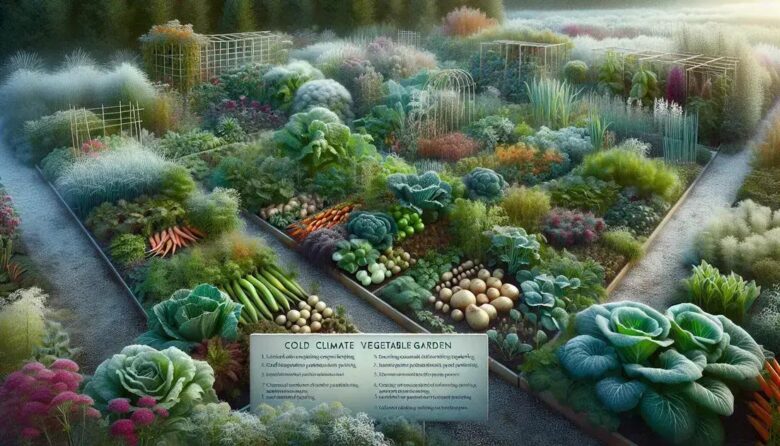Companion planting in cold climate permaculture can transform your vegetable garden into a thriving ecosystem. Ever wondered how some plants help others grow better? Let’s dive into sustainable gardening techniques that boost your veggies even when the temperature drops. A few strategic plant choices might just make all the difference in your garden’s success.
understanding companion planting principles
Companion planting is a strategy used in permaculture to cultivate plants together for mutual benefits. Understanding this approach starts with learning how certain plants influence one another’s growth. Some plants repel pests, while others improve soil nutrients, or provide necessary shade.
Why It Works
The primary principle of companion planting is enhancing plant relationships to create a balanced ecosystem. For instance, growing beans near carrots can help improve soil nitrogen, supporting healthier growth for both plants. Similarly, marigolds are known to deter nematodes, protecting the roots of nearby vegetables.
Starting Small
If you’re new to companion planting, start with a few basic combinations, like tomatoes and basil. Basil helps repel insects that can damage tomatoes. Observe these interactions to learn and build more complex planting schemes over time. This method not only boosts yield but also encourages biodiversity.
Building a Sustainable Garden
Consider soil types, plant spacing, and watering needs to tailor companion planting strategies to your garden. Proper planning is key to maximizing the effectiveness of companions. Always select combinations that align with your climate conditions and gardening goals.
By understanding companion planting principles, you can cultivate a thriving, sustainable garden that benefits all plant inhabitants.
choosing the right plant companions for cold climates
When growing vegetables in cold climates, selecting appropriate plant companions is crucial. Certain plants not only survive the cold but also support their neighbors by enhancing nutrient availability and providing shelter. For example, sturdy, fast-growing plants like kale can protect more delicate plants from harsh winds.
Intercropping Benefits
Intercropping is a strategy where different plants are grown together to maximize space and resources. In cold climates, root vegetables like carrots and onions can be excellent companions. Onions deter pests that might attack carrots, creating a natural pest control strategy.
Utilizing Ground Covers
Clover can be used as a ground cover to maintain soil temperature and moisture. It also fixes nitrogen in the soil, benefiting nutrient uptake for nearby plants. Planting clover around root vegetables not only improves soil health but also prevents erosion, crucial for colder regions with loose soils.
Maximizing Sunlight
In areas where sunlight is limited, arranging plants to maximize sun exposure is vital. Shorter plants should be placed in a way that doesn’t block sunlight from reaching taller or sun-loving plants behind them.
Choosing the right companions in cold climates leads to a resilient and productive vegetable garden by utilizing natural relationships between plants.
avoiding common companion planting mistakes
Companion planting can greatly benefit your garden, but certain mistakes can reduce its effectiveness. A common error is planting companions too closely, which can lead to crowding and competition for resources like nutrients and sunlight. This often results in weaker plant growth.
Incorrect Pairings
Pairing the wrong plants together is another frequent mistake. Some plants, like tomatoes and corn, should not be planted near each other as they attract similar pests. Always research plant compatibility before deciding which companions to use in your garden.
Ignoring Soil Requirements
Different plants have varied soil needs, and ignoring these can harm their growth. For example, some plants require well-drained soil, while others prefer moisture-retentive conditions. Planting companions with similar soil preferences ensures better growth and health.
Consideration of Growth Rates
Mixing plants with vastly different growth rates may lead to faster-growing plants overshadowing slower ones, limiting access to essential sunlight. Always consider how quickly each plant grows and place them accordingly to ensure all receive enough light.
Avoiding these common mistakes can help maximize the benefits of companion planting, allowing your garden to thrive naturally.
how permaculture principles enhance vegetable growth
Permaculture principles focus on designing agricultural systems that mimic natural ecosystems. One core principle is maximizing biodiversity, which encourages various plants to grow together, enhancing resilience against pests and diseases. Diverse gardens are less likely to experience total crop failure.
Soil Health and Structure
Healthy soil is foundational to vegetable growth. Permaculture emphasizes maintaining soil health through composting and mulching, providing essential nutrients, and retaining moisture. This allows vegetables to access the nutrients they need to thrive.
Water Management
Efficient water use is another principle. Techniques like rainwater harvesting and swales help capture and distribute water throughout the garden. Permaculture designs these systems to ensure that water reaches every plant without waste.
Natural Pest Control
Permaculture also boosts plant health by encouraging beneficial insects. Planting flowers like marigolds alongside vegetables attracts pollinators and predators of harmful insects, reducing the need for chemical pesticides.
Implementing permaculture methods not only supports vegetable growth but also fosters a self-sustaining garden environment.
seasonal planting strategies for cold climates
Planning your garden around the seasons is crucial in cold climates. Knowing when to plant helps ensure that your vegetables can thrive despite lower temperatures. Start by selecting cold-resistant crops like kale, carrots, and Brussels sprouts, which are known for enduring frost.
Timing is Everything
Begin with early spring planting for frost-tolerant seeds. Spinach and peas can be sown as soon as the soil is workable. Consider starting seeds indoors to get a head start, especially for plants like tomatoes that need a longer growing season.
Succession Planting
This technique involves planting new crops as others are harvested. By timing your plantings, you can ensure a continuous harvest from spring to fall. For example, plant lettuce early, followed by a later planting of broccoli in the same space.
Winter Protection
Use techniques like row covers and cold frames to extend the growing season. These structures trap heat and protect delicate plants from harsh weather. Mulching with straw also aids in insulating the soil and maintaining warmth.
Implementing these planting strategies will help you achieve a fruitful garden even in challenging climates.
real-life success stories in cold climate permaculture
Cold climate permaculture has produced numerous success stories that highlight its effectiveness. One inspiring example is the transformation of an urban backyard in Maine, USA, into a productive permaculture garden. By using raised beds and strategic plant pairings, the garden flourished despite the harsh winters.
Community Gardens
In Norway, community-driven permaculture projects have thrived, creating green spaces that offer food security. By integrating edible forests and greenhouse technologies, these projects extend growing seasons and support biodiversity.
Educational Impact
Schools in Canada are embracing permaculture to educate students about sustainable agriculture. Initiatives involve planting winter-hardy vegetables, teaching students hands-on skills in managing resources, and fostering a sense of environmental stewardship.
Innovative Techniques
Farmers in Sweden have experimented with combining permaculture practices with traditional farming. Results show improved soil health and increased crop yields, even in the face of cold conditions. Techniques like polyculture and using hedgerows as windbreaks have proven particularly effective.
These real-life examples demonstrate that with creative solutions, permaculture can be adapted to thrive in cold climates, benefiting communities and the environment.
Final Thoughts on Companion Planting for Cold Climates
Companion planting in cold climates offers a sustainable way to enhance vegetable gardens. By selecting the right plant combinations, you can improve yields and safeguard your crops from pests and harsh weather conditions.
Adopting permaculture principles, like maintaining biodiversity and effective water management, supports a thriving ecosystem. With examples of successful cold climate permaculture in mind, it’s clear that these methods can make a significant difference.
Whether you’re planting in an urban setting or a large field, permaculture strategies can help you create resilient gardens that adapt to and overcome environmental challenges.
Consider integrating these strategies into your gardening practices to make the most of your space and climate.
FAQ – Common questions about companion planting in cold climates
What are the benefits of companion planting in cold climates?
Companion planting enhances growth, improves soil health, and provides natural pest control which is especially beneficial in cold climates.
Which vegetables work well together in a cold climate garden?
Vegetables like kale and carrots pair well with onions and garlic, improving growth and deterring pests in cold climates.
How does permaculture support gardening in cold climates?
Permaculture helps build resilience through biodiversity and efficient resource management, promoting healthy plant growth even in cold weather.
Can I start seeds indoors for a cold climate garden?
Yes, starting seeds indoors gives them a head start and ensures they are strong enough to transplant when the weather improves.
What should I avoid when using companion planting?
Avoid overcrowding plants and pairing those with conflicting needs, like heavy feeders together, to prevent resource competition.
How can I protect my garden from frost?
Utilize row covers and cold frames to shield your garden from frost, maintaining warmth for the plants during colder months.



